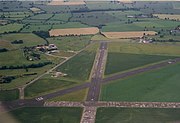RAF Sleap (pronounced "Slape") was a Royal Air Force airfield located 10 NM (19 km; 12 mi) north of Shrewsbury,[1] Shropshire, England. It was opened in April 1943, and used by RAF advanced flying training units. Initially it was the base for No. 81 Operational Training Unit RAF (OTU) within No. 93 Group RAF of RAF Bomber Command equipped with Armstrong Whitworth Whitley bomber aircraft.
From 1 January 1944 Sleap was assigned to the RAF's No.38 Group, Airborne Forces. 81 OTU's Whitleys towed Horsa heavy troop-carrying gliders on training missions and the Horsas made practice formation landings at Sleap to simulate the attacks to come on German-occupied territory. Vickers Wellingtons replaced the Whitleys from November 1944 and by January 1945 the strength was 51 T.Xs, being used to train Transport Command air crews. The RAF finally released Sleap in 1964, but the location is still used as a relief airfield by nearby RAF Shawbury for Squirrel helicopter training.
The Shropshire Aero Club members' bar (also a cafe open to the public) at Sleap is named after Bayston Hill born Flight Lieutenant Eric Lock the World War II Battle of Britain pilot who was the highest scoring British-born pilot in the battle with sixteen and a half victories during the epic battle. There is also a museum of wartime relics.

A view of the airfield from the north
Current[]
RAF Sleap is know known as Sleap Airfield (IATA: n/a, ICAO: EGCV).
Sleap Aerodrome has a United Kingdom Civil Aviation Authority Ordinary Licence (Number P641) that allows flights for the public transport of passengers or for flying instruction as authorised by the licensee (Shropshire Aero Club Limited).[2]
References[]
External links[]
The original article can be found at RAF Sleap and the edit history here.